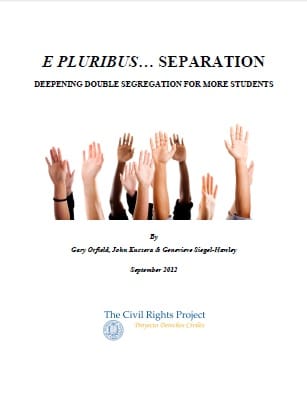 Gary Orfield’s Civil Rights Project routinely presents—and laments—stark numbers on segregation (both racial and socioeconomic) in U.S. classrooms; this latest report is no different. It shows that racial segregation is on the rise, even in the face of the shifting demographics of America’s schools (white students’ “market share” of public school enrollment dropped 25 percent over the past thirty years): Fifteen percent of black students and 14 percent of Latino students attend schools that are less than 1 percent white (and 74 and 80 percent, respectively, attend majority non-white schools). Further, while the typical white student attends a school that is about one-third low income; the typical black student’s school is about two-thirds low income. But what is the role of schools and school systems in arresting or reversing such trends, which have so much to do with housing policy, income, neighborhood demographics, ethnic preferences, and parental choice? Orfield has his own answers, of course: paternalistic policy recommendations that include expanding magnet schools, reversing Supreme Court decisions, and constructing civil-rights policies for charter schools. But forcibly creating diverse schools is as logistically taxing as it is politically unpalatable. Instead of top-down mandates, Orfield and co. might better consider a “controlled choice” approach to diverse schools—treating them as one component of a larger school-choice movement that allows parents to choose a high-performing charter or district-run STEM school, just as much as a diverse classroom.
Gary Orfield’s Civil Rights Project routinely presents—and laments—stark numbers on segregation (both racial and socioeconomic) in U.S. classrooms; this latest report is no different. It shows that racial segregation is on the rise, even in the face of the shifting demographics of America’s schools (white students’ “market share” of public school enrollment dropped 25 percent over the past thirty years): Fifteen percent of black students and 14 percent of Latino students attend schools that are less than 1 percent white (and 74 and 80 percent, respectively, attend majority non-white schools). Further, while the typical white student attends a school that is about one-third low income; the typical black student’s school is about two-thirds low income. But what is the role of schools and school systems in arresting or reversing such trends, which have so much to do with housing policy, income, neighborhood demographics, ethnic preferences, and parental choice? Orfield has his own answers, of course: paternalistic policy recommendations that include expanding magnet schools, reversing Supreme Court decisions, and constructing civil-rights policies for charter schools. But forcibly creating diverse schools is as logistically taxing as it is politically unpalatable. Instead of top-down mandates, Orfield and co. might better consider a “controlled choice” approach to diverse schools—treating them as one component of a larger school-choice movement that allows parents to choose a high-performing charter or district-run STEM school, just as much as a diverse classroom.
SOURCE: Gary Orfield, John Kucsera, and Genevieve Siegel-Hawley, E Pluribus...Separation: Deepening Double Segregation for More Students (Los Angeles, CA: The Civil Rights Project, September 2012).
